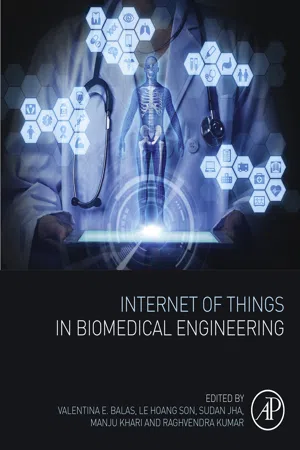
Internet of Things in Biomedical Engineering
- 379 pages
- English
- ePUB (mobile friendly)
- Available on iOS & Android
Internet of Things in Biomedical Engineering
About This Book
Internet of Things in Biomedical Engineering presents the most current research in Internet of Things (IoT) applications for clinical patient monitoring and treatment. The book takes a systems-level approach for both human-factors and the technical aspects of networking, databases and privacy. Sections delve into the latest advances and cutting-edge technologies, starting with an overview of the Internet of Things and biomedical engineering, as well as a focus on 'daily life.' Contributors from various experts then discuss 'computer assisted anthropology, ' CLOUDFALL, and image guided surgery, as well as bio-informatics and data mining.
This comprehensive coverage of the industry and technology is a perfect resource for students and researchers interested in the topic.
- Presents recent advances in IoT for biomedical engineering, covering biometrics, bioinformatics, artificial intelligence, computer vision and various network applications
- Discusses big data and data mining in healthcare and other IoT based biomedical data analysis
- Includes discussions on a variety of IoT applications and medical information systems
- Includes case studies and applications, as well as examples on how to automate data analysis with Perl R in IoT
Frequently asked questions
Information
CLOUDFALL 1.0: A Smart, Low-Cost, IoT-Based Fall-Detection Sensor Node
† G.N.D.U Regional Campus, Jalandhar, India
‡ Fairleigh Dickinson University, Vancouver, BC, Canada
Abstract
Keywords
1.1 Introduction

1.2 Related Studies
Table of contents
- Cover image
- Title page
- Table of Contents
- Copyright
- About the editors
- About the contributors
- Preface
- About the book
- Chapter 1: CLOUDFALL 1.0: A Smart, Low-Cost, IoT-Based Fall-Detection Sensor Node
- Chapter 2: Computer-Assisted Anthropology
- Chapter 3: Modeling a Fuzzy System for Diagnosis of Disease Syndromes of Traditional Vietnamese Medicine Combining Positive and Negative Rules
- Chapter 4: Image-Guided Surgery Through Internet of Things
- Chapter 5: IoT in Agriculture Investigation on Plant Diseases and Nutrient Level Using Image Analysis Techniques
- Chapter 6: Internet of Things in Healthcare: A Brief Overview
- Chapter 7: Artificial Intelligence Based Diagnostics, Therapeutics and Applications in Biomedical Engineering and Bioinformatics
- Chapter 8: Why Big Data and What Is It? Basic to Advanced Big Data Journey for the Medical Industry
- Chapter 9: Internet of Things Application in Life Sciences
- Chapter 10: Emerging Trends of IoT-Based Applications in Day-to-Day Life
- Chapter 11: Combining Predictive Analytics and Artificial Intelligence With Human Intelligence in IoT-Based Image-Guided Surgery
- Chapter 12: Internet of Things Technologies
- Chapter 13: Medical Big Data Mining and Processing in e-Healthcare
- Index